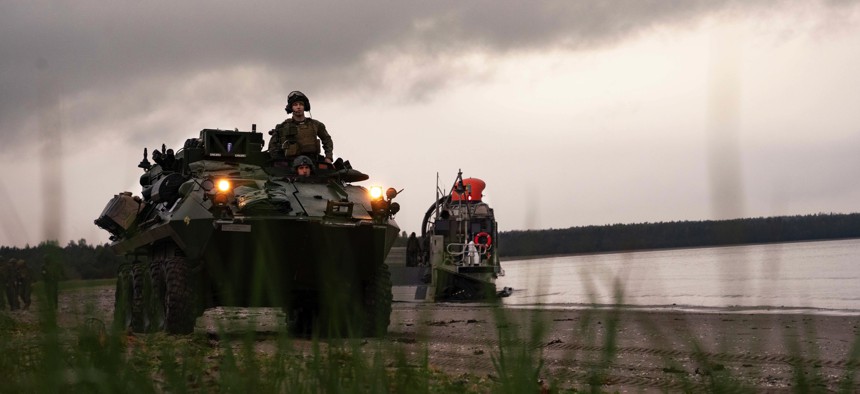
As part of the Estonian-led exercise Siil 22, U.S. Marines with the 22nd Marine Expeditionary Unit off-load from LCACs on Saaremaa Island, Estonia, on May 20, 2022. U.S. Marine Corps / Staff Sgt. Brittney Vella
NATO Forges Plans to Surge Forces to Baltics In a Crisis
Estonia is planning new training areas and infrastructure under a defense budget increase.
TALLINN, Estonia–NATO defense chiefs on Saturday discussed how to prepare Baltic member states to receive large numbers of troops from allied nations during a major crisis with Russia. Meanwhile, Estonia is working to deter Russia by increasing its defense budget, buying air defenses and ammunition, and planning new training areas and infrastructure, Estonian officials said on Saturday.
The defense chiefs discussed ways to implement goals from June’s NATO summit, particularly how and when the troops would arrive, what they will bring, and what preparations the Baltic governments must make, Adm. Rob Bauer, chair of NATO’s Military Committee, told reporters here.
“Sometimes, the host nations need to do certain things to make sure that they can actually receive the troops, receive extra ammunition, receive extra vehicles, and make sure that they can kind of allow and have the facilities for those additional forces to train, for example,” Bauer said.
The Estonian defense chief, Lt. Gen. Martin Herem, said, “We must find the balance between in-place forces and forces which may come here, which are exercising the deployment here. And then we have to find out how many additional permanent military bases we need here. But yes, I can say that, I don't think we need brigade-size units permanently here…I don't think it's efficient.”
Bauer said the defense chiefs agreed to a number of exercises in the coming year to work out those concepts so that “we can actually show the countries—but also our publics—that that process is actually working.”
Other Estonian officials outlined various steps the country is taking to accommodate NATO’s forward defense posture.
“We need to increase our readiness. Since January, we have made significant investments to increase our ammunition stocks, improve existing capabilities,” Prime Minister Kaja Kallas said during the conference “In addition, we are establishing a new divisional structure, which will create better conditions for a possible NATO response in our region.”
Kusti Salm, the permanent secretary at the Estonian Ministry of Defense, told reporters on Saturday, “We are going to build infrastructure, expand training areas. We are building mid-range air defenses.”
All of that preparation, plus Estonia’s other defense efforts, will cost money. The government plans to increase its defense spending to 2.8% of GDP, up from 2.3% in 2020. Said Salm: “That's a huge commitment. This is what we are doing. And you know, we're quite confident that our closest allies will follow.”
Estonia and other NATO allies are short of what they need to deter Russia, according to Martin Hurt, a research fellow at the International Centre for Defense and Security in Estonia. Hurt noted that helping Ukraine has drained many European militaries of ammunition.
“They could spend those stocks in peace-support operations in the Balkans, in Afghanistan, in Iraq. They didn't spend much money on buying new and replacing them because they had ammunition for decades. But now they have run out of that. A number of nations have publicly stated that.”
To better deter Russia, Hurt said, all of those countries will need more than what they are used to because any conflict with Russia would likely last much longer than Europeans are currently prepared. “We see from Ukraine and their successful operations early this year that you need something that will not last for weeks or even a month. You need to be able to fight for months, especially if you're a neighbor to Russia, because who are the countries who will support you? …The others are, like I described, they are short of everything, actually.”





